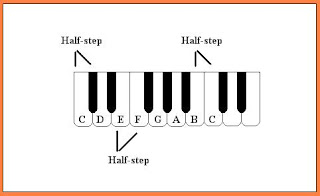Reading sheet music is like reading a foreign language. There are rules and patterns that must be followed for the music to sound pleasing to the ear and so the musician can interpret the music correctly in order to perform it.
Before we get to the music, we must first know how to write it correctly, understand the notes, and know how to organize it.
To learn about how to correctly label a note, head to: http://nomusicbflat.blogspot.com/2012/09/what-is-c4.html
To learn about clefs, head to:http://nomusicbflat.blogspot.com/2012/12/lesson-2-staffs-clefs-and-lines-oh-my.html
To learn about the major scale and whole and half steps, head to:
http://nomusicbflat.blogspot.com/2013/01/lesson-3-major-and-minor-scale.html
To learn about key signatures, head to:
http://nomusicbflat.blogspot.com/2013/01/lesson-4-key-signatures.html
To learn about notes and their rhythms in simple meter, head to:
http://nomusicbflat.blogspot.com/2013/01/lesson-5-notes-and-rhythm-part-i.html
To learn about simple time signatures, head to:
http://nomusicbflat.blogspot.com/2013/01/lesson-6-simple-time-signatures.html
To learn about rests in simple time, head to:
http://nomusicbflat.blogspot.com/2013/01/lesson-7-rests.html
To learn about ties and slurs, head to:
http://nomusicbflat.blogspot.com/2013/01/lesson-8-ties-and-slurs.html
To learn about dotted notes and rests: head to:
http://nomusicbflat.blogspot.com/2013/01/lesson-9-dotty-good-time.html
Now we will learn about compound time.
Compound time is when meter is divided into groups of three, instead of groups of two [see lesson 5: notes and rhythms part 1 above]
The beat note in compound time is divisible by three. This is why all beat notes in compound time are dotted. A dotted note divides into three eighth notes.
In compound time, the numerator of the time signature will always be the number of beats in a measure times three[hence compound,]. The denominator is the number representing the notes used in the division of the beat note. If the beat note is the dotted quarter note, the denominator will be 8 because the beat note [dotted quarter] divides into three eighth notes. Three division notes added together make one beat note. If you know the beat note, division note, and the number of beats per measure, you can determine the time signature, and if you know the time signature, you can also determine the number of beats per measure, beat note, and division note.
Lets do some practice:
1) In 6/8 time, what is the number of beats in a measure? What is the beat note?
2) What time signature has 3 beats in a measure, and it's beat note is a dotted eighth note?
3) How many dotted quarter notes are in 12/8 time?
b) Is the dotted quarter note the beat note or the division note? How do you know?
4) What is the division note in 9/16 time?
5) Is 3/8 in simple or compound time? Why or why not?
After you complete those, here is a display of some common compound time signatures.
Now we know:
- the difference between simple and compound time signatures
- how to identify the number of beats, beat note, and division note from the time signature
- how to identify the time signature while knowing the number of beats, beat note and division note.
This concludes the lesson for.... oh wait!!!! You probably want those answers to the questions, now don't you! See, I didnt tell you that the answers would be down here because then you would have come straight down here for the answers instead of trying them, or at least, I hope so.
Answers:
1) 6/8 time: there are two beats in a measure, and the beat note is the dotted quarter note.
2) 9/16 : 3 beats of 3 sixteenth notes each= 9/16
3) 4: dotted quarter note is the beat note of 12/8 time, and 12/3=4
b) the dotted quarter note is the beat note because 8 is the denominator, so the eighth note is the division note. 3 division notes make a beat note, and three eighth notes makes a dotted quarter note.
4) sixteenth note: 16 is the denominator, so the sixteenth note is the division note.
5) simple time: the numerator in compound time must be divisible of three, but NOT 3. time signatures with a numerator of 2, 3, or 4 are in simple time.
This concludes our lesson for today.
























